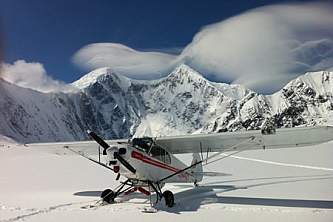Cape Krusenstern National Monument
Cape Krusenstern National Monument is a coastal plain with big lagoons, backed by gently rolling, limestone hills. Archeological sites trace 4,500 years of human use of its coastline by prehistoric peoples who occupied it seasonally to hunt marine mammals, especially seals. As big storms and regular wind and wave action formed new beach ridges, camps were made on those close to the water. Oldest sites are on beach ridges farthest from the ocean. Over centuries this made a timeline giving a definite, datable outline of northwest Alaska's cultural succession and development. The Cape Krusenstern area is a designated Archeological District in the National Register of Historic Places and a National Historic Landmark
Today, as for centuries, primary human use of Cape Krusenstern is subsistence hunting, fishing, and gathering by Inupiaq Eskimos of nearby villages. Wildlife includes caribou, grizzly bears, wolves, red foxes, lynx, and wolverines, with walrus, polar bears, seals, and whales found offshore at various times of year.
Access: Daily jet service from Anchorage to Kotzebue-chartered air taxis from Kotzebue to the monument. From Kotzebue, fly with Golden Eagle Outfitters. A boat charter is available in summer by advance arrangement. Approximate Size: 660,000 acres. For Information contact: Superintendent, Cape Krusenstern National Monument, P.O. Box 1029, Kotzebue, Alaska 99752-1029; 907-442-3890; www.nps.gov/cakr

